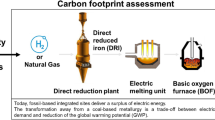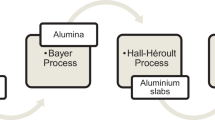Abstract
In the modern electric arc furnace (EAF), more than 40 % of energy comes from chemical sources by fossil fuels: natural gas is used in dedicated burners during the melting of the scrap, while lump coal (mainly anthracite) is added to the basket and pulverized coal is injected as a foaming agent.
Within the frame of the European Research Fund for Coal and Steel (RFCS), the ongoing project GREENEAF (RFSR-CT-2009-004) is studying the possibility to replace coal and natural gas in EAF with char and syngas produced by biomass pyrolysis.
The best pyrolysis conditions to obtain the proper syngas and char quality have been defined by laboratory tests using biomass available in the surrounding of the partners steel shops. Industrial trials have been performed in three different EAF plants. The results demonstrated the technical feasibility of the approaches, while the economical evaluation has showed the sustainability of replacing the coal with char from biomass in addition to environmental benefits due to CO2 reduction.
Zusammenfassung
Im modernen Elektro-Lichtbogenofen (EAF) werden mehr als 40 % der Energie in Form von fossilen Brennstoffe eingebracht: Erdgas wird mit speziellen Brennern während des Schmelzens des Schrotts verwendet, während Kohle (hauptsächlich Anthrazit), in stückiger Form mit dem Schrottkorb chargiert wird und als Feinkohle über Einblaselanzen zur Schaumschlackenbildung eingebracht wird.
Im Rahmen des Europäischen Forschungsfonds für Kohle und Stahl (RFCS), untersucht das laufende Projekt GREENEAF (RFSR-CT-2009-004) die Möglichkeit, Kohle und Erdgas im EAF durch Char (dem festen Pyrolyserückstand) und Synthesegas aus der Pyrolyse von Biomasse zu ersetzen.
Die besten Pyrolysebedingungen, um die erforderliche Qualität des Synthesegases und Chars zu erreichen, wurden durch Labortests definiert, in denen Biomasse verwendet wurde, die in der näheren Umgebung der Stahlwerke der beteiligten Projektpartner verfügbar sind. Industrielle Untersuchungen wurden in drei verschiedenen EAF Anlagen durchgeführt. Die Ergebnisse zeigten die technische Machbarkeit der Ansätze, während die wirtschaftliche Bewertung die Nachhaltigkeit für den Ersatz der Kohle mit Char aus Biomasse, zusätzlich zu ökologischen Nutzen aufgrund der CO2-Reduktion, gezeigt hat.








Similar content being viewed by others
References
Pfeifer, H.; Kirschen M.; Simoes, J. P.: Thermodynamic Analysis of EAF Electrical Energy Demand, Proceedings of 8th European Electric Steelmaking Conference Birmingham, May 9–11 (2005), pp 211–232
Ultra Low Carbon Dioxide Steelmaking, RFSR-CT-2004-00005 Project (2009), www.ulcos.org
Teodoro da Costa, R.; Mayrink Morais, F.: Charcoal, Renewable Energy Source for Steelmaking Process, Rev. Met. Paris, 5 (May 2006), pp 203–209
Acknowledgments
The project ‘Sustainable EAF steel production—GREENEAF’ was carried out with a financial grant of the Research Fund for Coal and Steel, (Contract Number RFSR-CT-2009-00004, project started on 01/07/2009 and closure on 30/06/2012).
Author information
Authors and Affiliations
Corresponding author
Rights and permissions
About this article
Cite this article
Bianco, L., Baracchini, G., Cirilli, F. et al. Sustainable Electric Arc Furnace Steel Production: GREENEAF. Berg Huettenmaenn Monatsh 158, 17–23 (2013). https://doi.org/10.1007/s00501-012-0101-0
Received:
Accepted:
Published:
Issue Date:
DOI: https://doi.org/10.1007/s00501-012-0101-0




